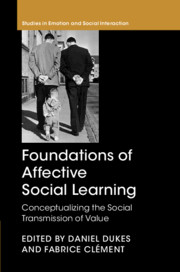Book contents
- Foundations of Affective Social Learning
- Studies in Emotion and Social Interaction
- Foundations of Affective Social Learning
- Copyright page
- Dedication
- Contents
- Figures
- Contributors
- Preface
- A difficult introduction to affective social learning
- Part I On the evolutionary foundations of affective social learning processes
- Part II On human development and affective social learning
- Part III On the mechanics of affective social learning
- Part IV Applications of affective social learning
- Conclusion
- Index
- Studies in Emotion and Social Interation
- References
A difficult introduction to affective social learning
Published online by Cambridge University Press: 09 August 2019
- Foundations of Affective Social Learning
- Studies in Emotion and Social Interaction
- Foundations of Affective Social Learning
- Copyright page
- Dedication
- Contents
- Figures
- Contributors
- Preface
- A difficult introduction to affective social learning
- Part I On the evolutionary foundations of affective social learning processes
- Part II On human development and affective social learning
- Part III On the mechanics of affective social learning
- Part IV Applications of affective social learning
- Conclusion
- Index
- Studies in Emotion and Social Interation
- References
Summary
Affective social learning is a relatively new concept that needed teasing out. In this introductory chapter, we set out what we meant by the notion as we initially set it out in previous versions. The goal here is to provide the reader with the background to the concept and indeed to the following chapters and, ultimately, to use as a starting point when measuring how the concept evolves over the length of the book. We begin then, by explaining how difficult it can be, conceptually, to marry three important areas of (psychological) research – emotion (affect), the ‘social’ and learning, before setting out the conditions and describing the major components involved in affective social learning. We end by briefly introducing the following chapters.
Keywords
- Type
- Chapter
- Information
- Foundations of Affective Social LearningConceptualizing the Social Transmission of Value, pp. 1 - 22Publisher: Cambridge University PressPrint publication year: 2019
References
- 3
- Cited by

